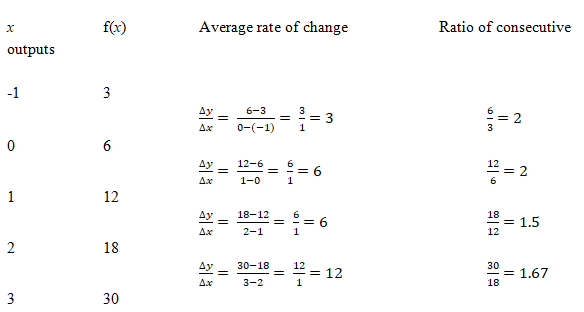
To find: The function is linear, exponential or neither.
Answer to Problem 25AYU
Solution:
Neither linear function nor exponential function.
Explanation of Solution
Given:
| x | -1 | 0 | 1 | 2 | 3 |
| f( x ) | 3 | 6 | 12 | 18 | 30 |

From the above table, the average rate of change from -1 to 0 is 3, and the average rate of change from 0 to 1 is 6. Because the average rate of change is not constant, the function is not a linear function. The ratio of consecutive output from -1 to 0 and 0 to 1 is 2, and the ratio consecutive output from 1 to 2 is 1.5. Because the consecutive output from is not a constant, the function is not an exponential function. Therefore the given function is neither linear nor exponential.
Chapter 5 Solutions
Precalculus Enhanced with Graphing Utilities
Additional Math Textbook Solutions
Thinking Mathematically (6th Edition)
Elementary Statistics: Picturing the World (7th Edition)
Pre-Algebra Student Edition
Elementary Statistics
Elementary Statistics (13th Edition)
A First Course in Probability (10th Edition)
- could you explain this pleasearrow_forwardthe answer is C, could you show me how to do itarrow_forward7. [-/1 Points] DETAILS MY NOTES SESSCALCET2 6.1.505.XP. Evaluate the integral. (Use C for the constant of integration.) 21z³e² dz | 21 Need Help? Read It SUBMIT ANSWER 8. [-/1 Points] DETAILS MY NOTES SESSCALCET2 6.1.020. Evaluate the integral. 36 In y dy ₤36 25 Need Help? Read It SUBMIT ANSWER 9. [-/1 Points] DETAILS MY NOTES SESSCALCET2 6.1.009. Evaluate the integral. (Use C for the constant of integration.) In(7x In(7x + 1) dxarrow_forward
- 10. [-/1 Points] DETAILS MY NOTES SESSCALCET2 6.1.506.XP. Evaluate the integral. √xy dy Need Help? Read It Watch It SUBMIT ANSWER 11. [-/1 Points] DETAILS MY NOTES SESSCALCET2 6.1.023. Evaluate the integral. 1/2 7 cos-1 x dx Need Help? Read It Watch It SUBMIT ANSWER 12. [-/1 Points] DETAILS MY NOTES SESSCALCET2 6.1.507.XP. Evaluate the integral. L² 0 (In x)² x3 dx Need Help? Read Itarrow_forwardi attached the question and the way i solved it, i believe i made an error, could you point it out for me because the correct answer is 3pi/2correct answer is D, please see both attached photosarrow_forwardQuestion 3 and 4arrow_forward
- could you explain this pleasethe answer is has sum 1but i dont know how to calculate itarrow_forwardcan you explain why the answer is 1/3arrow_forwardThe position of a particle that moves along the x-axis is defined by x = - 3t^2 + 12^t - 6 f, where t is in seconds. For the time interval t = 0 to t = 3 s, (1) plot the position, velocity, and acceleration as functions of time; (2) calculate the distance traveled; and (3) determine the displacement of the particleshow the graph and write the solution with a penarrow_forward
 Calculus: Early TranscendentalsCalculusISBN:9781285741550Author:James StewartPublisher:Cengage Learning
Calculus: Early TranscendentalsCalculusISBN:9781285741550Author:James StewartPublisher:Cengage Learning Thomas' Calculus (14th Edition)CalculusISBN:9780134438986Author:Joel R. Hass, Christopher E. Heil, Maurice D. WeirPublisher:PEARSON
Thomas' Calculus (14th Edition)CalculusISBN:9780134438986Author:Joel R. Hass, Christopher E. Heil, Maurice D. WeirPublisher:PEARSON Calculus: Early Transcendentals (3rd Edition)CalculusISBN:9780134763644Author:William L. Briggs, Lyle Cochran, Bernard Gillett, Eric SchulzPublisher:PEARSON
Calculus: Early Transcendentals (3rd Edition)CalculusISBN:9780134763644Author:William L. Briggs, Lyle Cochran, Bernard Gillett, Eric SchulzPublisher:PEARSON Calculus: Early TranscendentalsCalculusISBN:9781319050740Author:Jon Rogawski, Colin Adams, Robert FranzosaPublisher:W. H. Freeman
Calculus: Early TranscendentalsCalculusISBN:9781319050740Author:Jon Rogawski, Colin Adams, Robert FranzosaPublisher:W. H. Freeman
 Calculus: Early Transcendental FunctionsCalculusISBN:9781337552516Author:Ron Larson, Bruce H. EdwardsPublisher:Cengage Learning
Calculus: Early Transcendental FunctionsCalculusISBN:9781337552516Author:Ron Larson, Bruce H. EdwardsPublisher:Cengage Learning





